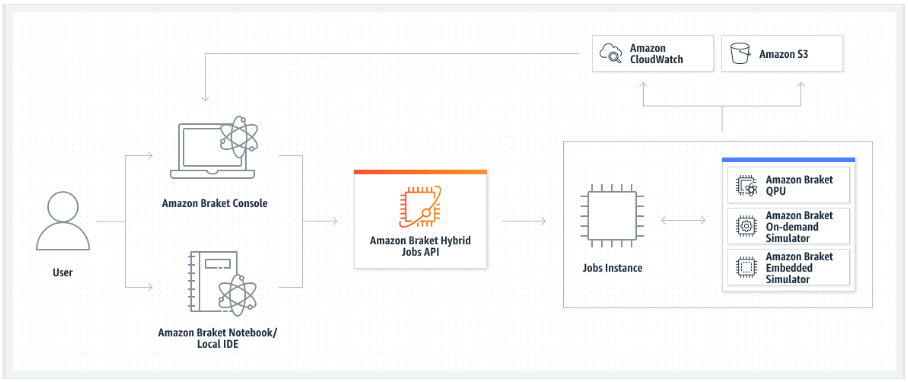Working with Amazon Braket Hybrid Jobs
Amazon Braket Hybrid Jobs offers a way for you to run hybrid quantum-classical algorithms requiring both classical AWS resources and quantum processing units (QPUs). Hybrid Jobs is designed to spin up the requested classical resources, run your algorithm, and release the instances after completion so you only pay for what you use.
Hybrid Jobs is ideal for long-running, iterative algorithms that involve the use of both classical computing resources and quantum computing resources. With Hybrid Jobs, after submitting your algorithm to run, Braket will run your algorithm in a scalable, containerized environment. Once the algorithm has completed, you can then retrieve the results.
Additionally, quantum tasks that are created from a hybrid job benefit from higher priority queueing
to the target QPU device. This prioritization ensures that your quantum computations are processed and ran ahead of other tasks waiting in the queue.
This is particularly advantageous for iterative hybrid algorithms, where the results of one quantum task depend on the outcomes of prior quantum tasks. Examples of such algorithms include the
Quantum Approximate Optimization Algorithm (QAOA)
You can access hybrid jobs in Braket using:
-
The Amazon Braket API.
In this section:
When to use Amazon Braket Hybrid Jobs
Amazon Braket Hybrid Jobs enables you to run hybrid quantum-classical algorithms, such as the Variational Quantum Eigensolver (VQE) and the Quantum Approximate Optimization Algorithm (QAOA), that combine classical compute resources with quantum computing devices to optimize the performance of today's quantum systems. Amazon Braket Hybrid Jobs provides three main benefits:
-
Performance: Amazon Braket Hybrid Jobs provides better performance than running hybrid algorithms from your own environment. While your job is running, it has priority access to the selected target QPU. Tasks from your job run ahead of other tasks queued on the device. This results in shorter and more predictable runtimes for hybrid algorithms. Amazon Braket Hybrid Jobs also supports parametric compilation. You can submit a circuit using free parameters and Braket compiles the circuit once, without the need to recompile for subsequent parameter updates to the same circuit, resulting in even faster runtimes.
-
Convenience: Amazon Braket Hybrid Jobs simplifies setting up and managing your compute environment and keeping it running while your hybrid algorithm runs. You just provide your algorithm script and select a quantum device (either a quantum processing unit or a simulator) on which to run. Amazon Braket waits for the target device to become available, spins up the classical resources, runs the workload in pre-built container environments, returns the results to Amazon Simple Storage Service (Amazon S3), and releases the compute resources.
-
Metrics: Amazon Braket Hybrid Jobs provides on-the-fly insights into running algorithms and delivers customizable algorithm metrics in near real-time to Amazon CloudWatch and the Amazon Braket console so you can track the progress of your algorithms.
Running a hybrid job with Amazon Braket Hybrid Jobs
To run a hybrid job with Amazon Braket Hybrid Jobs, you first need to define
your algorithm. You can define it by writing the algorithm script and,
optionally, other dependency files using the Amazon Braket Python SDK
In either case, next you create a hybrid job using the Amazon Braket
API, where you provide your algorithm script or container, select the
target quantum device the hybrid job is to use, and then choose from a variety of optional
settings. The default values provided for these optional settings work for the majority of
use cases. For the target device to run your Hybrid Job, you have a choice between a QPU,
an on-demand simulator (such as SV1, DM1 or
TN1), or the classical hybrid job instance itself. With an on-demand simulator
or QPU, your hybrid jobs container makes API calls to a remote device. With the embedded
simulators, the simulator is embedded in the same container as your algorithm script. The
lightning
simulators

If your target device is an on-demand or embedded simulator, Amazon Braket starts running the hybrid job right away. It spins up the hybrid job instance (you can customize the instance type in the API call), runs your algorithm, writes the results to Amazon S3, and releases your resources. This release of resources ensures that you only pay for what you use.
The total number of concurrent hybrid jobs per quantum processing unit (QPU) is restricted. Today, only one hybrid job can run on a QPU at any given time. Queues are used to control the number of hybrid jobs allowed to run so as not to exceed the limit allowed. If your target device is a QPU, your hybrid job first enters the job queue of the selected QPU. Amazon Braket spins up the hybrid job instance needed and runs your hybrid job on the device. For the duration of your algorithm, your hybrid job has priority access, meaning that quantum tasks from your hybrid job run ahead of other Braket quantum tasks queued up on the device, provided the job quantum tasks are submitted to the QPU once every few minutes. Once your hybrid job is complete, resources are released, meaning you only pay for what you use.
Note
Devices are regional and your hybrid job runs in the same AWS Region as your primary device.
In both the simulator and QPU target scenarios, you have the option to define custom algorithm metrics, such as the energy of your Hamiltonian, as part of your algorithm. These metrics are automatically reported to Amazon CloudWatch and from there, they display in near real-time in the Amazon Braket console.
Note
If you wish to use a GPU based instance, be sure to use one of the GPU-based
simulators available with the embedded simulators on Braket (for example,
lightning.gpu). If you choose one of the CPU-based embedded simulators
(for example, lightning.qubit, or braket:default-simulator),
the GPU will not be used and you may incur unnecessary costs.